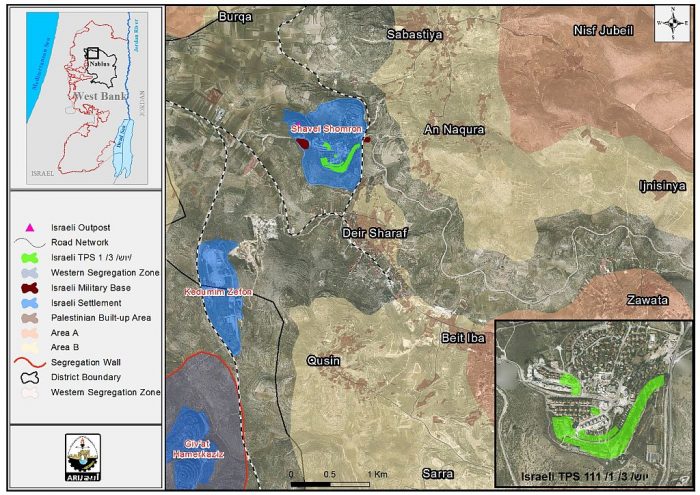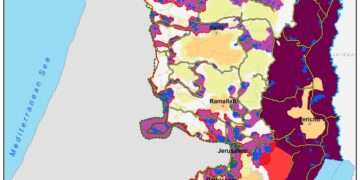On the 5th of September 2016, the Israeli High planning council affiliated to the so-called Israeli Civil Administration (ILA) advertised a new announcement in Al Quds newspaper regarding the deposit of a plan designated for expanding Shavei Shomron settlement in Nablus Governorate. The publication, which was signed by Eng. Natalia Orbuch, head of the Israeli Settlement sub-committee at the Israeli Civil Administration in the occupied Palestinian territory, and declares the building of 69 new housing units in the settlement of Shavei Shomron. The plan holds number יוש/ 3/ 1/ 111 and targets around 44.36 dunums of lands of An Naqura village.
Photo 1: The announcement of the plan in Al Quds newspaper
Photo 2: Israeli Plan number יוש/ 3/ 1/ 111

Map 1: Israeli Plan number יוש/ 3/ 1/ 111
Details of the plan come as follow
|
Table 1: Details of plan number יוש/ 3/ 1/ 111 |
||||||
|
|
TPS No. יוש/ 3/ 1/ 111 |
TPS No. יוש/ 2/ 1/ 111 |
||||
|
Type of Building |
Area (Dunums) |
Percent |
No. of units |
Area (Dunums) |
Percent |
No. of units |
|
Residences Area A |
2.40 |
5.41 |
6 |
26.05 |
58.72 |
65 |
|
Residence Area A1 |
15.42 |
34.76 |
54 |
—– |
—– |
—– |
|
Industrial Area |
—– |
—– |
|
8.69 |
19.58 |
—– |
|
Open Public Area |
1.52 |
3.43 |
—– |
4.75 |
10.70 |
—– |
|
Buildings and public institutions |
1.01 |
2.28 |
—– |
—– |
—– |
—– |
|
Buildings and public educational institutions |
16.51 |
37.22 |
—– |
3.63 |
8.18 |
—– |
|
Employment area ,public buildings and institutions |
6.92 |
15.60 |
—– |
—– |
—– |
—– |
|
Approved Road |
—– |
—– |
—– |
1.24 |
2.79 |
—– |
|
Proposed Road |
0.58 |
1.31 |
—– |
—– |
—– |
—– |
|
Total |
44.36 |
100 |
|
44.36 |
100 |
|
|
Source: Israeli Ministry of Interior, 2016 |
||||||
Note that plan number יוש/ 3/ 1/ 111 proposes a change in a previously issued detailed master plan No. יוש/ 2/ 1/ 111 which suggests the designation of land for industrial areas and public institutions in the settlement. Provisions of the plan come as follow:
- Land rezoning from residential, open public spaces and industries to: buildings and public educational institutions, a working zone in addition to the integration of buildings and public institutions.
- Changing of parcels from single family housing unit to double family housing units
- Modifying land use from "open public area and residence area (A)" to "public buildings area."
- Setting limits and provisions in the area with regard to construction plan.
- Amending regression lines of land lots No. 349 and 350. See Photos 3-7
Photos 3-7: Details of plan number יוש/ 3/ 1/ 111
The plan states that “according to chapter No. 20/24 of the Israeli City, Village, and Building Planning Law no. 79 of 1966[1], the Israeli settlement sub-committee declares the deposit of the Town Planning Scheme (TPS) No. יוש/ 3/ 1/ 111 as an amendment to town planning scheme No. detailed master plan No. יוש/ 2/ 111/1.
Photo 8: Plan number יוש/ 2/ 1/ 111
The plan further indicates that “anyone who has interest in the plan and considers himself /herself affected, has the right to file his/her objection. A written objection must be submitted and supported by all the documents that support his/her objection including a map of the area or any other document that can identify the location of the property and land and its relation to affected land owners" … "Affected owners must also attach a certified statement by a lawyer who attests the reasons upon which the objection was submitted."
Note that in the year 1971, the Israeli Occupation authorities ‘amended’ “Law of Planning of Cities, Villages, and Buildings No.79” of the year 1966 in accordance with Israeli Military Order number 418, under which all significant decisions on permits and plans would be made by a High Planning Council appointed by the Military Commander. MO No. 418 also allowed the High Planning Council to prepare, amend, cancel, disregard, or dispense any plan or permit; it also had the authority to exempt persons from obtaining the necessary license. Most members of the High Planning Council have been military officers and all have been Israeli citizens. The amendment to this law has advanced the establishment of new settlements and the expansion of existing ones while it prohibited the natural development of the Palestinian community simply by rejecting permits and demolishing Palestinian houses under the pretext of building without proper building authorization
To conclude
Israel’s policy of approving building plans in settlements in the occupied Palestinian territory is one of the main issues in the conflict between Israelis and Palestinians. Israeli settlements are built on confiscated Palestinian land and contribute much to the displacement of Palestinians from their owned land and severely limit the Palestinian urban expansion and development.
The Israeli Occupation practices in the occupied Palestinian territory constitute a breach to the various international law rules and norms, some of which are listed below
- The Fourth Geneva Convention states in Article 49 that “The occupying power shall not deport or transfer parts of its own population into the territories it occupies.” and Article 174 of the same convention “prohibits the 'extensive destruction and appropriation of property not justified by military necessity and carried out unlawfully and wantonly.”
- Article 33 of the Fourth Geneva Convention prohibits collective punishment, and land leveling and property destruction carried out by Israeli forces are collective punishments. The article states: 'No protected person may be punished for an offence he or she has not personally committed. Collective penalties and likewise all measures of intimidation or of terrorism are prohibited.”
- Article 147 of the convention considers 'extensive destruction and appropriate of property, not justified by military necessity and carried out unlawfully and wantonly' as a grave breach of the Convention and thus constitute a war crime.
- Article XXXI of the 1995 Oslo agreement Israel is forbidden from building or planning to any project or settlements or any colonial expansion or any plan that lead to change the status of the West Bank and Gaza Strip. The article provides “Neither side shall initiate or take any step that will change the status of the West Bank and the Gaza Strip pending the outcome of the permanent status negotiations”.
- Furthermore, the existence of the Israeli settlements in the West Bank and their expansions are Illegal and contradicts with the international law rules, United Nations Security Council Resolutions such as 237 (1967), 271 (1969), 446 (1979), 452 (1979) ,465 (1980.
- Resolution 446 March 22, 1979 calls on Israel to rescind its previous measures and to desist from taking any action which would result in changing the legal status and geographical nature and materially affecting the demographic composition of the Arab territories occupied since 1967, including Jerusalem and, in particular, not to transfer parts of its own civilian population into the occupied Arab territories"
- Also the resolution 452 of the 1979 “calls upon the Government and people of Israel to cease, on an urgent basis, the establishment, construction and planning of settlements in the Arab territories occupied since 1967, including Jerusalem.
Prepared By
The Applied Research Institute – Jerusalem
ARIJ



















